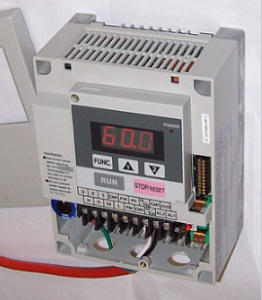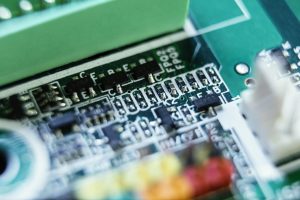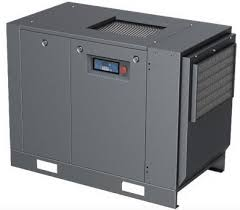
What is Variable Frequency Drive(VFD)?
August 23 2023 
Inquiry
Global electronic component supplier AMPHEO PTY LTD: Rich inventory for one-stop shopping. Inquire easily, and receive fast, customized solutions and quotes.
QUICK RFQ
ADD TO RFQ LIST
In this blog, what variable frequency drive is and how it works will be discussed. Moreover, its features, applications, and the ways that it saves energy will be further dug out. At the end of the blog tell about the advantages and disadvantages of VFD to understand this fantastic device.
What is Variable Frequency Drive?
A variable frequency drive or VFD, also known as a variable speed drive (VSD), is an electronic device used to control the speed and torque of an electric motor. It works by adjusting the frequency and voltage supplied to the motor, allowing for precise control of motor speed and acceleration.
How Variable Frequency Drive Works?
Input Power: The VFD receives AC power from the main supply. This power is typically at a fixed frequency and voltage. Rectifier: The incoming AC power is first passed through a rectifier, which converts it into DC power. The rectifier is usually a diode bridge that consists of diodes arranged in a specific configuration to convert the AC power into a pulsating DC waveform. DC Bus: The rectified DC power is then smoothed and filtered by a capacitor, creating a stable DC voltage known as the DC bus voltage. The DC bus acts as an intermediate power source for the rest of the VFD components. Inverter: The inverter section of the VFD is responsible for converting the DC power back into AC power with variable frequency and voltage. It comprises insulated gate bipolar transistors (IGBTs) or other semiconductor devices that can switch on and off rapidly. Pulse Width Modulation (PWM): The inverter uses a technique called Pulse Width Modulation (PWM) to control the output voltage and frequency. PWM involves rapidly switching the IGBTs on and off to create a series of voltage pulses. By adjusting the width of these pulses, the average voltage and frequency supplied to the motor can be controlled. Motor Control: The variable frequency and voltage output from the inverter are then supplied to the motor. The motor responds to these varying voltages and frequencies, resulting in adjustable speed and torque. The VFD continuously monitors and adjusts the output parameters based on the desired speed and load conditions. Control Interface: VFDs are equipped with a control interface that allows users to set and adjust various parameters such as motor speed, acceleration/deceleration rates, and operating modes. This interface can be a keypad, control panel, or computer software. By varying the frequency and voltage supplied to the motor, a variable frequency drive provides precise control over motor speed and acceleration. This allows for energy savings, improved process control, and reduced mechanical wear and tear. Variable frequency drives find applications in various industries, including HVAC systems, pumps, fans, conveyors, and machine tools, where precise motor control is required.What is Variable Frequency Drive Used for?
Variable Frequency Drives (VFDs) are widely used in various industries and applications for their ability to control the speed and torque of electric motors. The followings list of some common uses of VFDs: HVAC Systems: Variable Frequency Drives are extensively used in heating, ventilation, and air conditioning (HVAC) systems. They allow for precise control of fan speeds, pump speeds, and compressor speeds, resulting in energy savings and improved efficiency. Industrial Machinery: VFDs are employed in a wide range of industrial machinery, such as conveyors, mixers, compressors, and machine tools. By adjusting the motor speed according to the process requirements, VFDs help optimize production, reduce energy consumption, and enhance equipment performance. Pumps and Fans: VFDs are commonly used in pumps and fans to control the flow rate or air volume. By adjusting the motor speed, VFDs can meet changing demands, maintain stable pressure, and reduce energy usage in applications like water treatment plants, irrigation systems, and HVAC systems. Conveyor Systems: VFDs play a crucial role in conveyor systems by controlling the speed and acceleration of the conveyor belt. This allows for efficient material handling, precise positioning, and the ability to handle different product sizes and weights. Process Control: VFDs are utilized in various process control applications where precise motor control is required. They enable fine-tuning of motor speed, torque, and acceleration, ensuring accurate control over critical processes such as chemical mixing, material handling, and packaging. Energy Savings: One of the significant advantages of VFDs is their ability to save energy. By controlling motor speed and eliminating the need for mechanical control devices like throttling valves and dampers, VFDs can significantly reduce energy consumption and operating costs. Renewable Energy Systems: VFDs are used in renewable energy systems such as wind turbines and solar power systems. They enable efficient power conversion, grid synchronization, and control of generator speeds, maximizing the energy output and stability of these systems. Retrofitting Existing Systems: VFDs can be retrofitted into existing motor-driven systems to upgrade their performance and energy efficiency. By replacing traditional fixed-speed motors with VFD-controlled motors, energy savings can be achieved without major equipment replacement. The versatility of Variable Frequency Drives makes them invaluable in numerous industries and applications by providing efficient motor control, energy savings, and improved process control. Their ability to adjust motor speed, torque, and acceleration according to the specific requirements of each application makes them a vital component in modern industrial and commercial systems.How Does Variable Frequency Drive Save Energy?
As I have mentioned before, one of the key advantages of VFDs is their ability to save energy. But how and in what ways? In this part, you will find out the answer.
Features of VFD
A range of features boasts VFD a versatile and effective tool for controlling the speed and performance of electric motors. The features of it include speed control, energy efficiency, soft start and stop, precise speed regulation, torque control, programmable logic controller (PLC) integration, and diagnostic and monitoring capabilities. Speed Control: One of the primary features of VFDs is their ability to control the speed of electric motors. By adjusting the frequency and voltage supplied to the motor, VFDs can precisely regulate the motor's rotational speed. This feature allows for flexible and efficient operation, enabling motor speed optimization for different applications. Energy Efficiency: VFDs are known for their energy-saving capabilities. By controlling the motor's speed based on the load requirements, VFDs can reduce energy consumption compared to fixed-speed drives. They achieve this by eliminating the need for mechanical throttling or other inefficient speed control methods, resulting in significant energy savings. Soft Start and Stop: VFDs provide a soft start and stop function, which minimizes mechanical stress on motors and connected equipment. Unlike traditional motor starters that cause abrupt voltage and current changes during startup and shutdown, VFDs gradually ramp up or down the motor's speed. This gentle acceleration and deceleration help extend the lifespan of motors and reduce wear and tear on mechanical components. Precise Speed Regulation: VFDs offer precise speed control over a wide range of motor speeds. Operators can set the desired speed with great accuracy, allowing for precise control in applications that require specific motor speeds. This feature is particularly beneficial in processes that involve delicate or sensitive operations. Torque Control: In addition to speed control, VFDs also provide torque control capabilities. They can maintain a constant torque output even as motor speed changes, ensuring consistent performance across varying load conditions. This feature is especially valuable in applications that require consistent torque output, such as conveyor systems or pumping operations. Programmable Logic Controller (PLC) Integration: VFDs can integrate with Programmable Logic Controllers (PLCs) and other automation systems. This allows for seamless communication and coordination between various components of a system, enabling centralized control and automation of motor-driven processes. PLC integration enhances system efficiency, flexibility, and ease of operation. Diagnostic and Monitoring Capabilities: Many modern VFDs come equipped with built-in diagnostic and monitoring features. These capabilities allow for real-time monitoring of motor performance, system status, and fault detection. By providing valuable data and alarms, VFDs enable proactive maintenance, troubleshooting, and prevention of potential issues, leading to improved reliability and reduced downtime. These features make VFDs a powerful tool in various applications, including HVAC systems, industrial processes, water treatment plants, and more. Their ability to provide precise control, energy efficiency, and system integration makes them a valuable asset in optimizing motor performance and enhancing overall system efficiency.What is the Difference between VSD and VFD?
VSD stands for Variable Speed Drive, while VFD stands for Variable Frequency Drive. Although these terms are often used interchangeably, there is a slight difference between them. The primary difference lies in the focus on control. A Variable Speed Drive (VSD) generally refers to any device or system that allows for the control of motor speed. It encompasses a wide range of technologies, including Variable Frequency Drives (VFDs), as well as other methods like mechanical speed control or hydraulic/pneumatic control systems. On the other hand, a Variable Frequency Drive (VFD) specifically refers to an electronic device used to control the speed of an electric motor by varying the frequency and voltage supplied to the motor. VFDs are the most common type of VSD used for motor speed control due to their efficiency, flexibility, and ability to provide precise control over motor speed. In summary, while all VFDs are VSDs, not all VSDs are VFDs. VFDs are a specific type of VSD that uses electronic frequency and voltage control to adjust motor speed. Other types of VSDs may use different mechanisms or technologies for motor speed control.Pros of VFD

Cons of VFD
While Variable Frequency Drives (VFDs) offer numerous advantages, there are also some potential disadvantages to consider: One significant disadvantage is the cost associated with VFDs. They can be more expensive upfront compared to traditional motor starters or fixed-speed drives. The initial investment includes not only the purchase of the drive itself but also installation costs and potential modifications to the electrical system. Another disadvantage is the complexity of VFDs. They involve intricate electronic components and control algorithms, which can make installation, setup, and troubleshooting more challenging. It often requires specialized knowledge and expertise to ensure proper installation and ongoing maintenance. VFDs can also introduce harmonics into the electrical system, which are additional frequencies that can interfere with other equipment or cause power quality issues. These harmonics can lead to increased electrical noise, voltage distortion, and potential electromagnetic interference (EMI). It's crucial to implement proper filtering and mitigation measures to address these concerns. Furthermore, VFDs can cause motor heating due to the switching of power electronics. This additional heat generation can lead to increased motor temperature, potentially impacting the motor's lifespan and reliability. Adequate cooling measures, such as ventilation or additional cooling fans, may be necessary to manage motor temperature effectively. Maintenance and repair of VFDs can be another disadvantage. While VFDs can reduce mechanical stress on motors, they introduce additional electronic components that may require maintenance or repair. The complexity of the drive can make troubleshooting and repair more time-consuming and costly. Having a proper maintenance plan in place, including regular inspections and preventive maintenance, is crucial. Additionally, VFDs may not always be compatible with all types of motors or equipment. Compatibility issues can arise due to motor insulation classes, bearing types, or mechanical resonance. Furthermore, VFDs can cause interference with sensitive electronic devices or communication systems if not adequately shielded or isolated. Lastly, using VFDs effectively requires a certain level of knowledge and expertise. Operators and maintenance personnel may need training to understand the drive's operation, parameter settings, and troubleshooting procedures. Investing in proper training and documentation is essential to ensure safe and efficient operation. Despite these potential disadvantages, VFDs continue to be widely used in various industries due to their energy-saving capabilities, precise control, and other benefits. When implemented correctly and with careful consideration of the specific application and system requirements, the advantages of VFDs often outweigh the potential drawbacks.Conclusion
In this blog, we have explored what VFD is and how it works, discussing its difference from VSD. We have also delved into the advantages and disadvantages of using VFDs in various applications. VFDs offer significant benefits such as energy savings, precise control, and reduced mechanical stress on motors. They are versatile tools that can optimize motor performance and provide flexibility in speed control. However, it is important to consider the potential drawbacks of VFDs. By comprehending the capabilities and limitations of VFDs, we can make informed decisions when it comes to implementing them in their systems.Related Articles
- ·The best MCUs/MPUs for industrial humanoid robots
- ·What are the advantages and disadvantages of using SoCs in embedded systems?
- ·How to convert Raspberry Pi to desktop PC?
- ·How to implement a multi class neural network with STM32F103?
- ·What are the differences between FPGA and DSP processors for signal processing?
- ·What are the differences between various Arduino boards?
- ·How do NPN and PNP sensors convert to each other?
- ·Comparison of ARM vs. RISC-V MCUs
- ·How to achieve serial communication between STM32 and ESP8266?
- ·What is the Difference Between 8085 and 8086 Microprocessor?
Populer Posts
